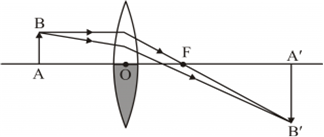One-half of a convex lens is covered with a black paper. Will such a lens produce an image of the complete object? Support your answer with a ray diagram.
(b) An object 5 cm high is held 25 cm away from a converging lens of focal length 10 cm.
(i) Draw the ray diagram and
(ii) Calculate the position and size of the image formed.
(iii) What is the nature of the image?
(a) Image is formed by a large number of rays from the object. If one part of the lens is blackened, image will be formed. But, intensity of the image will be reduced.

(b) i)

Object distance, u = -25 cm
Focal length, f = 10 cm
Height of the image, h = 5 cm
ii) Now, using the lens formula,
(iii) Negative sign indicates that the image is real & inverted.





